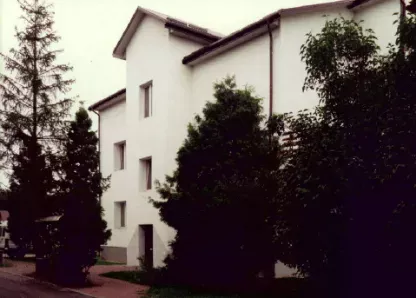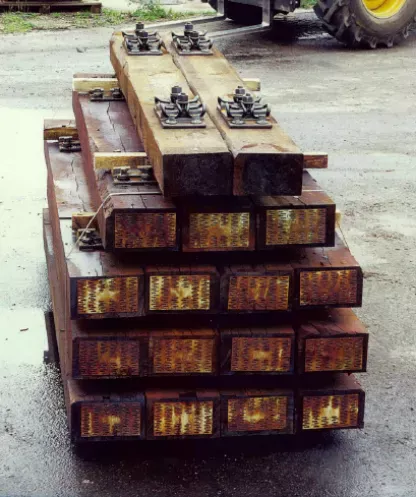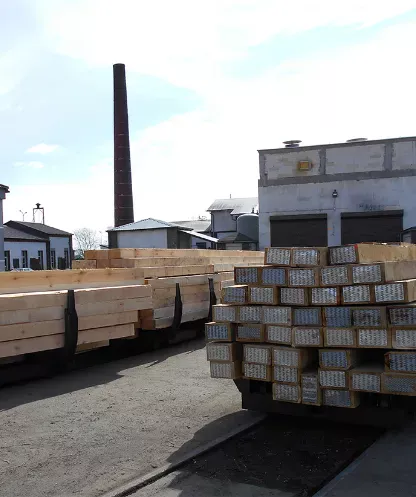ABOUT US
Sleeper Treatment Plant in Czeremcha is the major manufacturer of railway superstructure in Poland. This also means more than 80 years of tradition. The plant was built between 1938 and 1939 by Union of Coking Plants in Katowice at a 17-ha area. The plant was commissioned on 1 May 1939.
In June 2010 as a result of sale of shares by the Polish National Treasury, the new owner of Sleeper Treatment Plant in Czeremcha became Kolejowe Zakłady Nawierzchniowe (KZN) “Bieżanów” sp. z o.o. in Cracow.
Vast experience, tradition and qualifications of employees ensure fluid supplies and fast completion of orders, owing to which we are the most competitive on the market.
We offer full range of any materials and accessories. Thanks to such trade policy, the Sleeper Treatment Plant in Czeremcha fully meets the needs of the market and constantly adapts its offer to growing requirements of Customers.
As the first and only sleeper treatment plant in Poland, we offer oil-treated wood surface materials “Type C” (WEI-C)
Information concerning plant with increased risk of occurrence of industrial breakdown
pursuant to art. 261a of the Environmental Protection Law (Journal of Laws of 2016, item 672 as amended)
- Designation of plant operator
Sleeper Treatment Plant in Czeremcha
ul. Fabryczna 7
17-240 Czeremcha
Plant Manager – Mr. Ryszard Stanisław Sokołowski – President of the Board
- Qualification of Plant
The Sleeper Treatment Plant in Czeremcha, due to amount of stored hazardous material (CREOSOTE EN 13991 Grade C GX-plus), has been classified as plant with increased risk of occurrence of industrial breakdown – in accordance with Regulation of the Minister of Development of 29 January 2016 on types and amount of hazardous materials being present within plant premises, critical for plant to be classified as plant with increased risk of occurrence of industrial breakdown (Journal of Laws of 2016, item 138).
The plant is subject to provisions concerning prevention of serious industrial breakdowns. Pursuant to art. 250 and 251 of the Environmental Protection Law (Journal of Laws of 2016, item 672 as amended) The plant notified relevant information and submitted program for prevention of industrial breakdowns to relevant authorities: the State Fire Service and Province Inspector of the Environmental Protection.
- Description of business activity
The plant is mainly involved in treatment of wood products with impregnation oil using pressure-vacuum method, and also by wood sawing.
- Description of stored hazardous materials critical for plant to be classified as plant with increased risk of occurrence of serious industrial breakdown
Name: Creosote EN 13991 Grade C GX-plus
CAS Number: : 8001-58-9.
Physical properties
|
State |
liquid |
|
Colour |
light brown |
|
Odour |
aromatic |
Classification according to Regulation (EC) No. 1272/2008 [CLP/GHS]
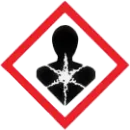
Carc. 1B
Repr. 2
H350
H361fd
May cause cancer
Suspected of damaging fertility. Suspected of damaging the unborn child.
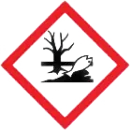
Aquatic Chronic 2
H411
Toxic to aquatic life with long lasting effects.
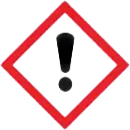
Skin Irrit. 2
Eye Irrit. 2
Skin Sens. 1
H315
H319
H317
Irritating to skin.
Irritating to eyes.
May cause an allergic skin reaction.
- Methods of warning and response of population in case of occurrence of industrial breakdown, agreed with relevant authorities of the State Fire Service
In the case of occurrence of breakdown or condition indicating such possibility, the local population shall be alerted by means of:
- alarm sirens present within plant premises,
- public address systems on police and fire service vehicles,
- local radio stations.
Raising and recalling alarm with sirens:
- raising alarm: modulated siren sound for 3 minutes,
- raising alarm: continuous siren sound for 3 minutes.
In case of occurrence of industrial breakdown:
- when staying nearby breakdown:
- leave the affected area by moving perpendicularly to wind direction,
- notify other people on hazard,
- take care of minors, elderly and handicapped people,
- follow instructions given by rescue services;
- when staying in enclosed room:
- remain inside until alarm is recalled,
- tune radio/television receiver to frequencies of local station channel,
- tightly close doors, windows and vents,
- turn off blowers, fans and other mechanical ventilation devices,
- wait until alarm is recalled.






